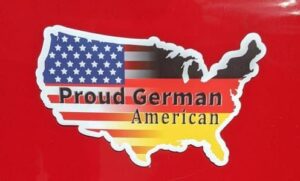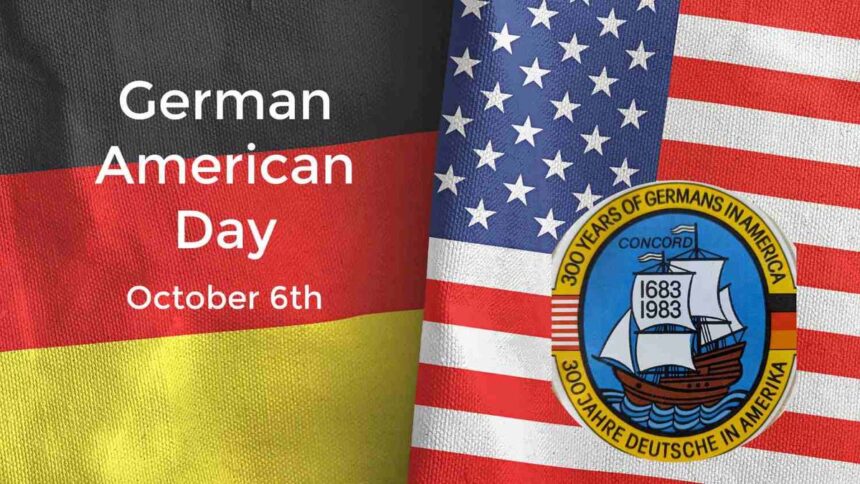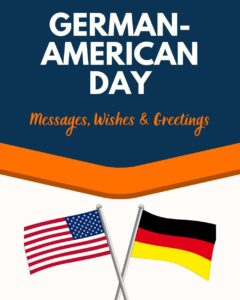🇩🇪🇺🇸 7 Inspiring Facts That Prove German-American Day Is More Powerful Than You Think
🌟 Introduction: More Than Just a Cultural Celebration
German-American Day, observed every year on October 6th, is not just another day marked on the calendar. It’s a celebration of heritage, innovation, and the shared dreams between Germany and the United States.
- 📜 History of German-American Day
- 🧭 Timeline of German-American Day
- 🌍 7 Inspiring Facts About German-American Legacy
- 🧠 FAQs – German-American Day
- Q1: Why is German-American Day celebrated on October 6?
- Q2: How many Americans claim German ancestry?
- Q3: Was German-American Day ever canceled?
- Q4: How is it celebrated?
- Q5: Is it a public holiday?
- ✨ Significance of German-American Day
- ✅ 1. Celebrating Diversity
- ✅ 2. Honoring Sacrifices
- ✅ 3. Encouraging Education
- ✅ 4. Bridging Two Nations
- 🎉 Observances & Celebrations
- 💌 German-American Day Wishing Examples
- 🏡 Importance in Daily Life
- 💡 Key Takeaways
- 🌟 Conclusion: A Day of Legacy, Love, and Learning
From the earliest settlers to world-renowned scientists, engineers, artists, and entrepreneurs—German immigrants and their descendants have played a huge role in shaping America. This day honors not only history but also mutual respect, cultural richness, and the value of diversity.
📜 History of German-American Day
The first German immigrants to the U.S. arrived on October 6, 1683, and founded Germantown, Pennsylvania.
These settlers came aboard the ship “Concord”, seeking religious freedom and new opportunities.
The day was first celebrated as German Day in the 19th century.
It was discontinued during World War I due to anti-German sentiments.
President Ronald Reagan officially reinstated the holiday in 1983, marking the 300th anniversary of German immigration.
Since then, October 6 has been celebrated annually as a tribute to the contributions of over 40 million Americans of German descent.
🧭 Timeline of German-American Day
| Year | Event |
|---|---|
| 1683 | 13 German families settle in Germantown, PA |
| 1883 | First national celebrations for 200th anniversary |
| 1917 | Celebrations halted due to WWI |
| 1983 | President Reagan proclaims German-American Day |
| 1987 | Congress officially approves it as a national observance |
| Present | Celebrated annually on October 6 with parades, cultural events, and educational programs |
🌍 7 Inspiring Facts About German-American Legacy
🛬 German-Americans are the largest ethnic group in the U.S.
With over 40 million Americans tracing their roots to Germany, they form the largest ancestral group in the United States.🧠 They shaped science and innovation.
German-American scientists like Albert Einstein, Wernher von Braun, and many others transformed physics, aerospace, and engineering.🎶 From Beethoven to Bach to Beer!
The love for classical music, Oktoberfest, and craft beer culture in America has deep German influences.🛠️ German work ethic helped build American industries.
With a focus on precision, discipline, and innovation, German-American immigrants fueled the rise of manufacturing and skilled trades.📚 German is still the third-most commonly taught foreign language in U.S. schools, after Spanish and French.
🏡 Places like Milwaukee, St. Louis, and Cincinnati have strong German cultural roots, often called “German cities in America.”
🗽 German-Americans were leaders in liberty.
They helped abolish slavery, promote civil rights, and defend freedom in two World Wars—even when their loyalties were questioned.
🧠 FAQs – German-American Day
Q1: Why is German-American Day celebrated on October 6?
Because that’s the day in 1683 when the first 13 German families landed in Pennsylvania, founding Germantown.
Q2: How many Americans claim German ancestry?
According to the U.S. Census Bureau, more than 40 million Americans identify as having full or partial German ancestry.
Q3: Was German-American Day ever canceled?
Yes, it lost popularity during World War I due to anti-German sentiment but was revived in the 1980s.
Q4: How is it celebrated?
Celebrations include:
Cultural events and parades
Educational programs
Traditional German food, music, and folklore
German-American heritage month observances
Q5: Is it a public holiday?
No, it is not a federal holiday, but it is an official observance day in the United States.
✨ Significance of German-American Day
German-American Day serves several important purposes:
✅ 1. Celebrating Diversity
It reminds us of how immigrant cultures have built the United States, making it richer in ideas, food, music, and values.
✅ 2. Honoring Sacrifices
Many German-Americans have served in the military, led civil movements, and contributed to the nation’s success in times of war and peace.
✅ 3. Encouraging Education
Schools and universities often use this day to educate students about German language, art, and history.
✅ 4. Bridging Two Nations
It strengthens diplomatic and emotional ties between Germany and the U.S., fostering better understanding and global collaboration.
🎉 Observances & Celebrations
Here’s how communities celebrate German-American Day across the country:
Oktoberfest Parades with music and dance
Traditional German cuisine festivals
Language learning events in schools and libraries
German folk dance and storytelling evenings
Historical exhibits about German-American contributions
In cities like Chicago, Philadelphia, and New York, local German societies organize cultural shows, food fests, and parades.
💌 German-American Day Wishing Examples
Warm and cheerful wishes you can share:
“Wishing you a joyful German-American Day! May the roots of heritage always keep us grounded and grateful.”
“Let’s raise a stein to unity, strength, and shared dreams. Happy German-American Day!”
“To all who celebrate their roots and honor history—Happy German-American Day! 🇩🇪🇺🇸”
“May this day remind us that diversity is strength, and unity is power.”

🏡 Importance in Daily Life
You may not notice it, but German heritage touches your life every day:
| Element | German-American Influence |
|---|---|
| Food | Pretzels, sausages, beer culture |
| Language | Words like “kindergarten”, “dachshund”, “hamburger” |
| Values | Work ethic, punctuality, craftsmanship |
| Music | Classical music appreciation and instruments |
| Architecture | Timber-framed homes, barns, and design |
| Science | Contributions in physics, space, and chemistry |
German-Americans have deeply influenced education systems, music styles, and even the U.S. legal framework.
💡 Key Takeaways
German-American Day is more than symbolic—it’s a reminder of the value immigrants bring to the country.
It celebrates how German culture has blended seamlessly into American life, enriching it in countless ways.
The observance also acts as a lesson in tolerance, especially in today’s world, where cultural harmony is needed more than ever.
🌟 Conclusion: A Day of Legacy, Love, and Learning
German-American Day reminds us that identity is a mosaic of cultures, and every piece adds to the whole. From the founding of Germantown in 1683 to today’s multi-ethnic America, the journey of German immigrants is a story of hard work, innovation, and resilience.
In today’s divided world, this observance teaches us to respect, celebrate, and learn from each other—because that’s what builds a better, stronger, and more united future.
So next time you enjoy a pretzel, listen to Beethoven, or walk through a timber-style neighborhood—remember: you’re celebrating German-American heritage, knowingly or not.










I¦ve been exploring for a little for any high quality articles or blog posts in this sort of space . Exploring in Yahoo I eventually stumbled upon this site. Reading this info So i am glad to exhibit that I’ve a very good uncanny feeling I found out just what I needed. I such a lot for sure will make certain to don¦t overlook this website and provides it a look on a constant basis.